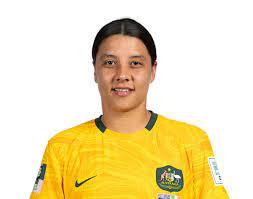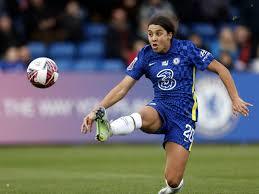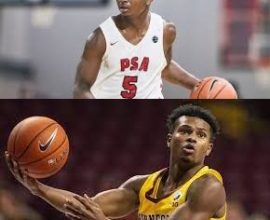
Sam Kerr Biography
Sam Kerr, whose full name is Samantha May Kerr, was born on September 10, 1993, in Fremantle, Western Australia. In 2019, she was named captain of the Matildas, Australia’s women’s national football team. Later, the team’s leading scorer all-time was the star striker. Kerr excelled in elite clubs in Australia, England, and the United States.

Sam Kerr Early life and career
In a family with a long history of athletics, Kerr was born the youngest of four children. Her father, Roger Kerr, was born in Kolkata to a mother who was a basketball player and a featherweight fighter for Bengal. He played Australian rules football, a contact sport with rugby-like characteristics, after relocating to Perth as a youngster. He played professionally for the South Australian National Football League and the West Australian Football League before transitioning to coaching in the WAFL. Sam Kerr’s brother Daniel Kerr, who was his eldest child, also became a professional football player.
Roxanne Kerr, Sam Kerr’s mother, was a niece and a daughter of WAFL players. Sam Kerr naturally played Australian rules football as a child because of this. However, growing ailments from playing the sport prompted her to switch to association football at the age of 12. She began playing junior-level football for several years before joining the Perth Glory football team in 2008, which is a part of the W-League, the highest level of professional women’s football in Australia. She joined the under-17 and under-20 Australian national teams in the same year.
Sam Kerr The Matildas
At the age of 15, Kerr made her Matildas debut as a substitute against Italy in 2009. She participated in her first significant competition, the Asian Cup, in China the following year. She scored the first goal in the team’s triumph over North Korea in the final, which helped the Matildas win their first championship ever. At the age of 17, Kerr participated in the Women’s World Cup for the first time in 2011, starting both of Australia’s games.

However, Kerr’s ascent was halted and her participation in the 2015 World Cup was in jeopardy due to a string of injuries. She was able to bounce back and started each of the Matildas’ five games that season. She scored her first goal on the international stage while participating in group play at the 2016 Olympic Games in Rio de Janeiro, Brazil. Before being defeated by Brazil, Kerr assisted the Australian squad in reaching the quarterfinals. In 2018, Kerr served as the Matildas’ driving force once more as they advanced to the Asian Cup final, losing to Japan by a razor-thin margin.
In advance of the Women’s World Cup in 2019, Kerr was selected as Australia’s captain. She not only scored Australia’s fourth goal in the team’s 4-1 group-stage victory over Jamaica, but also did so for the first time at the World Cup. Her four goals were just one short of Michelle Akers’ and Alex Morgan’s combined four-goal single-game record for the Women’s World Cup.
Australia advanced to the round of 16 thanks to its victory over Jamaica, where it was eliminated by Norway in a shootout. Despite this, Kerr continued her goal-scoring record by scoring six of the eleven goals for the Australian squad at the 2020 Olympic Games in Tokyo (which were postponed to 2021 because to the COVID-19 epidemic). In Australia’s defeat against the United States for the bronze medal, she scored her final Olympic goal. With her 48th goal for the national team, Kerr now holds the all-time record for the most goals scored by a Matilda.

Sam Kerr Clubs in the United States, England, and Australia
Kerr split her time between the W-League and the National Women’s Soccer League (NWSL), the premier division of American women’s soccer, in addition to competing for the Matildas. She spent time in the NWSL with the Western New York Flash (2013–14), Sky Blue FC (located in New Jersey, 2015–17), and Chicago Red Stars (2018–19). She achieved the feat in 2017 while competing for the Sky Blue, when she scored her 34th goal of her career against FC Kansas City. For the 2017 and 2019 seasons, Kerr received the Most Valuable Player award from the NWSL.
The Julie Dolan Award for best player was given to her twice while she was a member of the Perth Glory in the W-League; she won it in the 2016–17 and 2017–18 campaigns. 2019 saw Kerr score 64 goals for her career, making her the W-League’s all-time leading scorer as well.
End of 2019 saw Kerr sign with Chelsea FC of the top-tier Women’s Super League (WSL) of the Football Association of England. Early the next year, she joined the club for the first time. By the ensuing campaign (2020–21), Kerr had emerged as Chelsea’s top goal threat. With 21 goals that season, she assisted Chelsea in winning the WSL. She received the Golden Boot award for the WSL’s top scorer thanks to that total. In 2022, Kerr received the Order of Australia medal in honor of her contributions to the football industry.
football, any of a number of comparable games in which two players or teams try to kick, carry, throw, or otherwise move a ball toward the goal of the opposition. Some of these games solely allow kicking, while in others, kicking has lost importance in favor of other forms of propulsion.
See football (soccer), american football, rugby, australian rules football, and gaelic football for explanations of modern football sports.

Since humans have existed, there has been a natural urge to kick a round object. When two or more individuals competed in an attempt to kick a round item in one direction as opposed to another, the first game of football was played. More than 2,000 years ago, there was evidence of organized football games in Greece and China, but historians have no idea how these games were conducted.
It is likely that some form of football was played across the Roman Empire, although the game of harpastum, which is sometimes used as evidence for this assertion, appears to have included throwing the ball rather than kicking it. Native Americans in North America did participate in kicking sports, but stickball games—the precursor to the modern game of lacrosse—were much more common.
The 14th and 15th century’s popular football matches, which were typically played at Easter or Shrovetide, may have been inspired by paganism’s celebration of the return of spring through fertility rites. They were turbulent events. Everyone took part in the competition between villages when they kicked, threw, and carried a wooden or leather ball (or an inflated animal bladder) through fields, over streams, through small gates, and down even smaller streets. This included men and women, adults and children, the wealthy and the poor, laity and clergy.
When a particularly strong or able villager succeeded to send the ball through the portal of the rival village’s parish church, the tumultuous game came to an end. When folk football was limited to a single village, the teams were often made up of married people and single people, suggesting that the game’s beginnings were in reproductive rituals.

The sport was bloody. In Signification du sport (1968), Michel Bouet described the French variation, known as soule, as “a veritable combat for possession of the ball,” in which the players struggled “like dogs fighting over a bone.” The British version, which has been the subject of the most extensive investigation, was described as “a pleasurable form…of excitement akin to that aroused in battle” in Barbarians, Gentlemen and Players (1979) by Eric Dunning and Kenneth Sheard.
Unsurprisingly, legal documents are where the majority of the knowledge regarding medieval folk football comes from. In an effort to deny their recalcitrant subjects their chaotic pleasure, Edward II outlawed the game in 1314, and his royal successors repeated the ban in 1349, 1389, 1401, and 1423. The records of criminal trials nevertheless mention lives lost and property destroyed during an annual football game notwithstanding the restrictions. However, Richard Carew’s description of “hurling to goales,” from his Survey of Cornwall (1602), provides the most in-depth depiction.
The criticism of British folk football by Sir Thomas Elyot in The Governour (1537) suggests that the introduction of the Renaissance did not significantly advance its civilization. He criticized the games’ “beastely fury, and extreme violence.” Even James I tried to dissuade his countrymen from engaging in folk football, defending the legality of old English hobbies when they were decried by the Puritans. The “rough and violent” game was “more for mameing than making the [players] thereof able,” he claimed in Basilikon Doron; or, His Majesties Instructions to His Dearest Sonne, Henry the Prince (1603).
The rough-and-tumble game of folk football was replaced by the highly formalized and considerably less violent game of calcio in Renaissance Italy, which was played on bounded rectangular spaces set up in urban squares like Florence’s Piazza di Santa Croce. In his Discorso sopra il gioco del calcio fiorentino (1580; “Discourse on the Florentine Game of Calcio”), Giovanni Bardi stated that the players should be “gentlemen, from eighteen years of age to forty-five, beautiful and vigorous, of gallant bearing and of good report.”

Folk football was still played in France and Britain at the turn of the 20th century in places like Boulogne-la-Grasse and Ashbourne (Derbyshire) as a part of more or less intact local tradition. Despite the fact that all modern football sports have their origins in medieval folk football, they are more directly related to competitions held in schoolyards than on village greens or open spaces. Thomas Gray spoke of the “flying ball” and the “fearful joy” it brought to the “idle progeny” of England’s aristocracy in his poem “Ode on a Distant Prospect of Eton College” in 1747.
At public schools like Eton, Harrow, Shrewsbury, Winchester, and others, football was played in ways that were almost as bloody as the medieval version of the game in the late 18th and early 19th centuries. The elite students who attended these schools later transferred to Oxford and Cambridge but were hesitant to give up their “fearful joy.” The only logical course of action was to develop new games that combined the rules of several schools because none of them were prepared to play by the rules of someone else’s school.
England’s Football Association (1863) provided the institutional foundation for the most popular of these new games. A shorthand for “association football” was quickly adopted: “soccer.” Graduates of the Rugby School played rugby under the auspices of the Rugby Football Union (1871), who were accustomed to regulations that allowed carrying, throwing, and kicking the ball. Australian rules football was created when Thomas Wentworth Wills (1835–1880) blended the laws of Rugby with those of Harrow and Winchester. Rugby was swiftly replaced by gridiron football in the United States.
(The white stripes that crossed the field at 10-yard [9.1-meter] intervals gave the area its name.) Despite having similarities to these other “codes,” Gaelic football was formalized in 1884 under the direction of the Gaelic Athletic Association as a uniquely Irish alternative to the imported English sports of soccer and rugby.

Sam Kerr Awards & Nominations
- 2022 and 2023 FWA Women’s Footballer of the Year
- 2018, 2019, and 2022 ESPY Awards for Best International Women’s Soccer Player
- 2019 ESPY Award for Best NWSL Soccer Player
- 2017 and 2018 Julie Dolan Medal
- 5-time recipient of the PFA Australian Women’s Footballer of the Year
- 2013 and 2014 Football Media Association International Player of the Year
- 2019 Australian of the Year
Sam Kerr Social Media
- Instagram handle: Sam Kerr (@samanthakerr20)
- Facebook: Sam Kerr
- Twitter handle: Sam Kerr (@samkerr1)

Sam Kerr Personal Life
Sam Kerr, an accomplished Australian soccer player, is dating Kristie Mewis, a well-known American soccer player, who is also 29 years old. In 2021, they started dating, and they have been together ever since.
This couple is really close, but they haven’t yet had any kids. Sam Kerr once dated Nikki Stanton, a former teammate from the Perth Glory and Chicago Red Stars. She does not have a husband.
Sam Kerr Net Worth
Sam Kerr is one of the highest-paid female football players in the world, with an estimated net worth of $5 million. She receives a $525,000 yearly salary as well as additional bonuses from Chelsea Football Club.
Sam Kerr’s financial success is also enhanced by lucrative endorsement deals with well-known companies like CommBank, EA Sports, and Nike.
Where was Sam Kerr born?
East Fremantle, a suburb of Perth, Western Australia, is where Kerr was born. She is the child of Roger Kerr and Roxanne (née Regan).

How old was Sam Kerr when she started playing soccer?
On September 10, 1993, Samantha May Kerr was born in Fremantle, Australia. She used to play Australian rules football, a physical game comparable to rugby. But after suffering a series of injuries while playing, she switched to soccer at age 12.
How did Sam Kerr start her career?
Sam started playing football for the Western Knights at Mosman Park because the kid could only play against guys and there were no options for girls at the time. Sam made her W-League debut with Perth Glory in 2008 at the age of 15 after her teammates quickly recognized her talent on the field.
What are some interesting facts about Sam Kerr?
In either men’s or women’s soccer, Kerr became Australia’s all-time leading goal scorer.
She broke Tim Cahill’s previous record of 50 goals after scoring five goals in a match against Indonesia to raise her career total to 54.
Kerr has a total of five club championships to his name.

How long has Sam Kerr been playing football?
Due to gender-specific rules, Kerr switched from playing Australian rules football as a child to soccer at the age of 12. Bobby Despotovski, a striker for Perth Glory, first noticed her at the age of 13, and she made her W-League and international debuts in 2009 at the age of 15.
How much is Sam Kerr paid?
Sam Kerr, the Matildas captain, earned $3.3 million last year thanks to her salary and endorsement deals with Nike and EA Sports, making her pay package more than ten times that of her fellow Australian players.
Discover more from Labaran Yau
Subscribe to get the latest posts sent to your email.



















